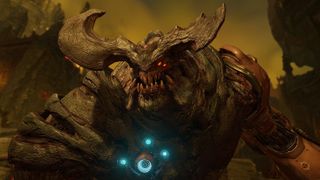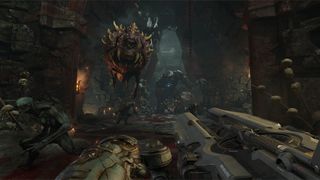Doom hands-on: teaching old demons new tricks

“SnapMap is our approach to making everybody, literally everybody who buys the game, have the ability to mod in some fashion,” Stratton says. “It doesn’t in our mind replace our desire to make our tools and technology available like we always have.”
Tying in with the philosophy of keeping things moving, Stratton says sharing SnapMap creations should be nearly instantaneous. “My favourite part about SnapMap is that everybody has all the data. So, if you’ve been a mod maker or somebody who makes levels or texture packs or whatever, to have somebody play your stuff requires you to upload it and them to download it, and things like Steam Workshop have made that easier. But with SnapMap, literally everybody has everything.” The result is that only a small instruction file is actually passed between clients as opposed to every single asset in the mod. “It doesn’t matter how complex a thing you build, it is as fast as a level load to have that data transferred.”
At QuakeCon, fans and press were handed a surprise: Doom multiplayer was actually playable, and all the talk about movement could be experienced first hand. All weekend, players lined up to play 6v6 team deathmatch in six-minute matches. While it doesn’t feel as fast as the original Doom—more than once I pressed the Shift button in hopes of getting a burst of speed—it’s defi nitely fast-paced and frantic, and movement is, as promised, king. One weapon is literally built to keep you moving. The static cannon fires an underwhelming zap unless you’ve charged it by running, in which case it delivers a massive blast that can devastate an opponent. With the static cannon in your hands the impulse to run, to watch that meter quickly fill and then unleash it on some sucker’s face, is almost addictive.

The rest of the weapons feel solid: the plasma rifle, which looked a bit wimpy in the trailer, is exciting to use, and each time you connect you’re given audio feedback reminiscent of Team Fortress 2’s critical hits. The alt-fire mode on the rocket launcher is great: a right-click lets you detonate rockets in mid-air, so just because an enemy side-steps your missile doesn’t mean you can’t still splash them.
While deathmatch only allows players to carry two guns at a time, along with either grenades or a personal teleporter, there are more powerful weapons spawning regularly in the arena, like the powerful gauss cannon, the only one-hit kill weapon in the arena. Also spawning intermittently on the map is a demon rune, which transforms the bearer into a towering, rocket-firing, jet-pack wearing Revenant. The appearance of these runes in different spots in the arena creates a roving control-point feel to the match, as everyone flocks to the rune’s location to fight over it. If the player-controlled Revenant is killed, the rune can’t be recaptured by the original team for a short period of time, meaning another brawl breaks out wherever it drops, with one team defending the rune and the other swarming in to nab it.
With other power-ups appearing, such as invisibility, armour, and a quad-damage token, players are constantly in motion. The level design of the map complements this, featuring curving corridors that feed you back into play, a lack of dead-ends, and plenty of catwalks, ledges, and pedestals to double-jump onto and mantle over. I played a half-dozen matches at QuakeCon, and despite them all taking place on the same single map, I could have easily sat there all weekend. I have to agree with Stratton: movement is king, stopping is death.
Whether they’re coming up with fresh takes on the classics, or adding completely new elements, the team at id has one other guideline—beyond the doctrine of movement—that they take into consideration when designing Doom . “We make decisions based on what we think is going to be most fun,” says Stratton. “Fun rules, for us.”
The biggest gaming news, reviews and hardware deals
Keep up to date with the most important stories and the best deals, as picked by the PC Gamer team.

Chris started playing PC games in the 1980s, started writing about them in the early 2000s, and (finally) started getting paid to write about them in the late 2000s. Following a few years as a regular freelancer, PC Gamer hired him in 2014, probably so he'd stop emailing them asking for more work. Chris has a love-hate relationship with survival games and an unhealthy fascination with the inner lives of NPCs. He's also a fan of offbeat simulation games, mods, and ignoring storylines in RPGs so he can make up his own.
Most Popular


